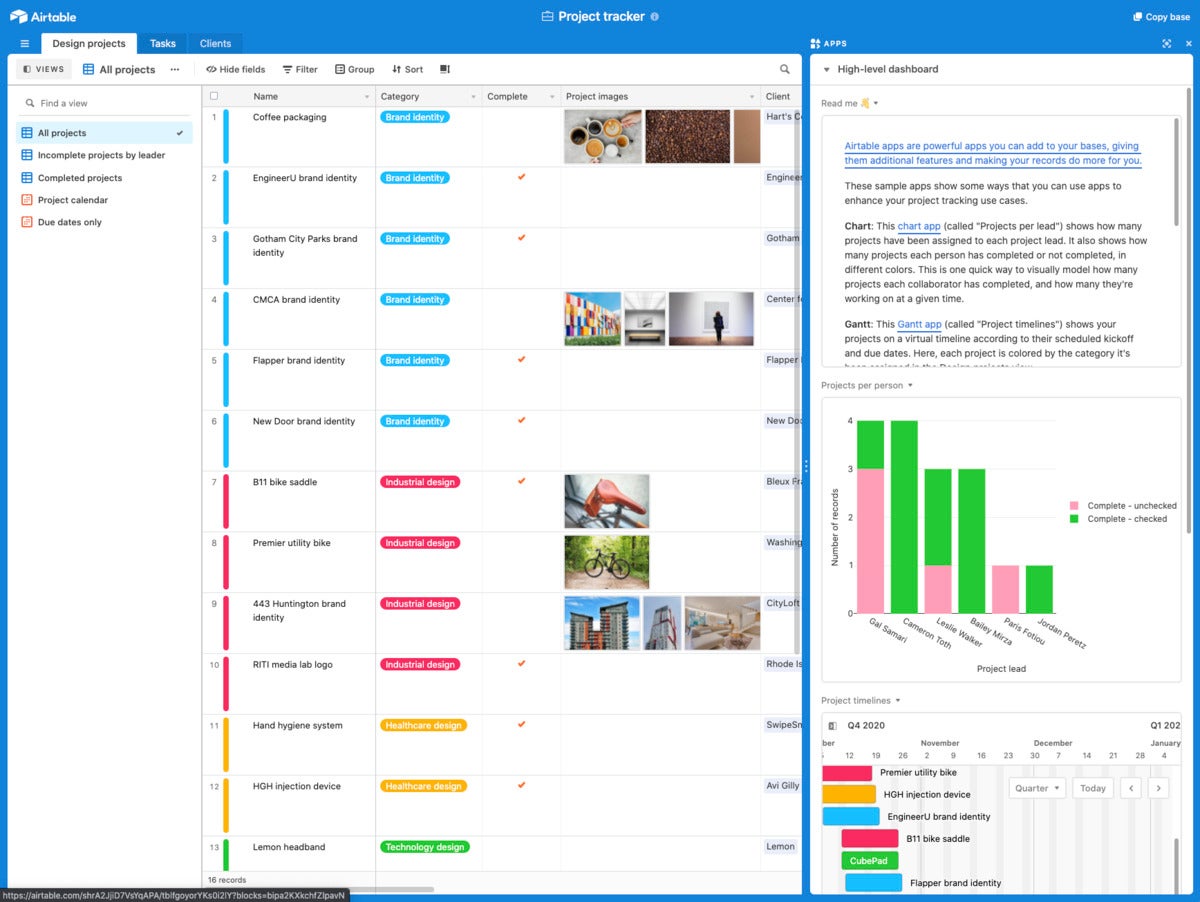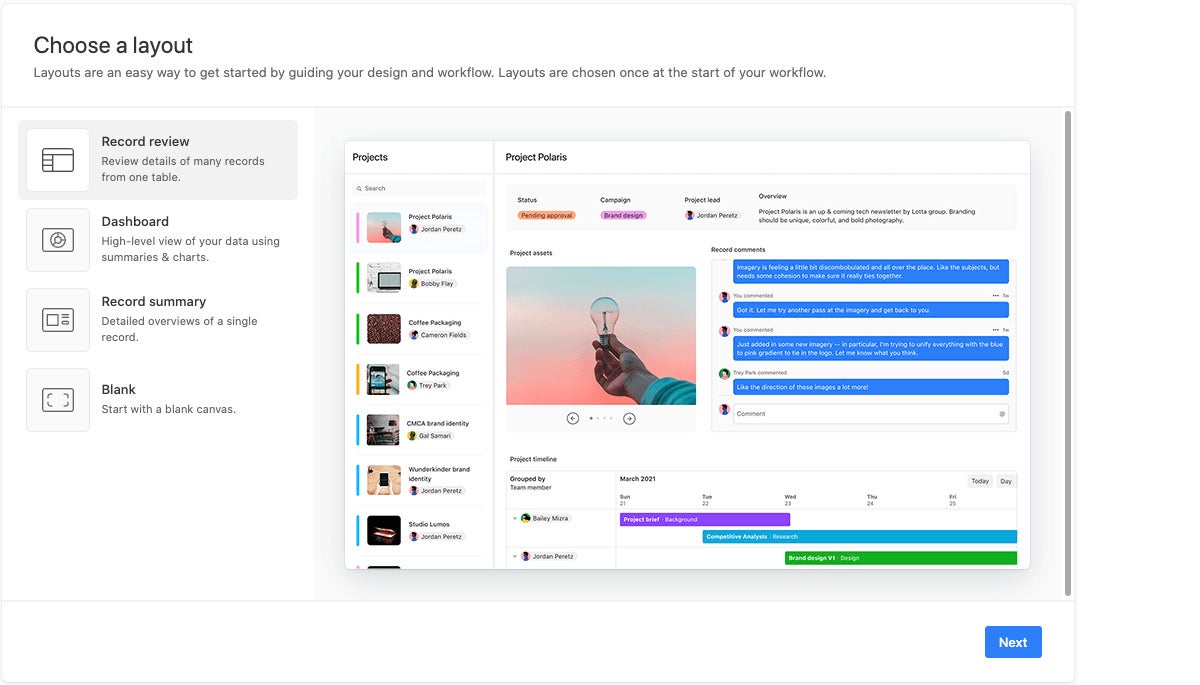Airtable review: Flexible low-code/no-code in the cloud
Airtable is a powerful combination of relational database capabilities, a variety of development environments for different skill levels, and hundreds of templates and add-ins for common use cases.
-
Airtable
Airtable may look like a spreadsheet in the cloud, but it’s actually more like a relational database in the cloud with its own development environment. That’s an oversimplification: Airtable has several development environments at a variety of skill levels ranging from non-programmers to power users to JavaScript programmers.
As a database-oriented, low-code/no-code development environment in the cloud, Airtable competes with many of the roughly 400 low-code/no-code app builders on the market, and certainly with the three major, cloud-specific low-code/no-code app builders, Amazon Honeycode, Microsoft Power Apps, and Google Cloud AppSheet. Airtable doesn’t really compete with the basic cloud spreadsheets such as Google Sheets.
Airtable concepts
Airtable is essentially a database in spreadsheet drag. An Airtable workspace, basically a collection of projects shared among a group of collaborators, contains one or more “bases,” where base is short for database. Each base contains one or more tables, and each table contains records (rows) and fields (columns). Airtable tables have homogeneous fields, like a relational database and unlike a NoSQL database.
Airtable tables can be displayed in an assortment of views. Unlike relational database views, Airtable views are not just filtered subsets of the data. In addition to allowing record filters and hidden fields, Airtable views support different formats for different purposes: grid view, calendar view, Kanban view, gallery view, Gantt view, timeline view, and form view. As we’ll see later, Airtable also supports formulas, automations, and apps.
Airtable integrates with over 30 other products. In addition, you can use Zapier, Workato, Integromat, or Automate.io to connect Airtable to mor than one-thousand websites and apps.
If this reminds you of Microsoft Access, Claris FileMaker, or Alpha Anywhere, welcome to the club. The basic difference is that the Airtable development environment is online, not desktop-based.
 IDG
IDG
The default view for an Airtable base is a grid. Note the list of views at the lower left and the starting points at right.
What’s new in Airtable?
2021 was a big year for Airtable innovation. Here are the highlights.
Interface Designer is a feature available in open beta that lets teams build visual, interactive interfaces using the data already in their bases. By creating custom interfaces for your teammates, you can display the information that’s critical to them and avoid distracting details.
Airtable added two new views, the Gantt view and the Timeline view. The difference between the two is that a Gantt chart includes dependencies so that you can use it to plan a project where one phase requires the completion of another, as is often the case in construction.
Easier view management includes favorite views and collapsible view sections. Mobile improvements include new mobile views, new calendars, @ mentions, and mobile data updating.
External source sync lets you continuously pull in data from outside platforms, integrating it directly into your Airtable workflow. Sync integrations include Salesforce, Jira Server and Jira Data Center, Zendesk, GitHub Issues, Google Calendar, Google Drive, and Box.
New automation features include triggering automations at a specified time and generating email previews, the ability to use formulas and lookups in automations, and a cleaner, easier automation UI. The admin panel has been streamlined, performance and monitoring have improved, and base management settings have improved.
Getting started with Airtable
The three options for getting started with Airtable are to start from scratch, import a data table, or start with a template. Starting from scratch assumes that you know what you want to build, which I don’t at the moment. Importing a data table (see the second screenshot below) assumes that you have data that relates to what you want to build, which I also don’t at the moment, although I imagine I have a few random CSV files or Excel sheets lying around that I could use in a pinch. That leaves Airtable’s templates, of which there are hundreds. (See the first screenshot below.) If you can’t find a supported product template that fits your use case, you can also try the community-contributed templates in Airtable Universe.
I picked out the official Project Tracker Template, which is supported by a half-hour recorded webinar. As you can see in the screenshots below, this template demonstrates a number of useful views and apps.
 IDG
IDG
Using templates is the recommended way to understand how Airtable bases and apps are constructed. The “Featured” category contains a dozen interesting templates.
 IDG
IDG
Airtable Project tracker template showing its “all projects” grid view and a high-level dashboard app.
 IDG
IDG
Airtable record editor for the Project tracker project. Note the use of attachments for images and links for records in related tables.
 IDG
IDG
Clicking on the “link to a record from clients” shown in the previous screenshot brings up a selection view using the Clients table.
Airtable formulas, scripts, and automations
Airtable has a number of features that give it more power than a no-code app builder. Formulas (see the first screenshot below) are a low-code feature, and may involve functions, numeric operations, logical operations, and text operations that operate on fields. Airtable formulas refer to fields by their names like a database application, not by a location as you’d expect in a spreadsheet.
Scripts are real JavaScript programs (see the second screenshot below), although they tend to be short and focussed on working with your Airtable base. Airtable provides JavaScript classes and methods for accessing and updating data in your base.
Automations allow you to configure custom workflows directly within your Airtable base. This will allow you and your team to save time by automating repetitive tasks, increasing communication efficiency, and reducing the overall margin of error. Automations start with a trigger, followed by one or more actions. Actions can operate inside or outside of Airtable to, for example, send emails or create Salesforce records.
 IDG
IDG
Airtable formula playground. This template base is a convenient reference for the 98 functions supported by Airtable.
 IDG
IDG
Airtable scripts use JavaScript and an Airtable API to let you manipulate your base and automate repetitive tasks.
Airtable Interface Designer
Interface Designer, currently in open beta, is a no-code, drag-and-drop builder for visual and interactive interfaces derived from your bases, replacing Airtable’s older Blocks tool. Interface Designer offers ways to simplify workflows, visualize data, and tailor information to different audiences across organizations.
Creating an interface (see screenshots below) involves picking a layout, designing on the canvas using elements and fields, customizing the elements you chose with property sheets, previewing the design, then publishing and sharing the interface.
The current four options for layouts are record review (showing details of many records from one table), dashboard (summaries and charts), record summary (showing details of one record), and a blank canvas.
Interface Designer really is in beta, even though the web-based design canvas seems solid. When testing a shared interface on Android, I ran into multiple bugs, none of which show up in a desktop browser.
 IDG
IDG
Creating an Airtable interface with Interface Designer starts by choosing one of four interfaces.
 IDG
IDG
The second step in creating an Airtable interface is to connect to a table. You can fill in the data options yourself or copy them from a view.
 IDG
IDG
Once you’re connected to a table you can pick which elements and fields you want to display on this interface.
 IDG
IDG
The Airtable interface editor. In addition to editing the interface, you can publish and share from this screen.
 IDG
IDG
Viewing an Airtable interface on Android. This is in landscape mode because the rendering in portrait mode didn’t scroll horizontally.
Low-code/no-code in the cloud
As we’ve seen, Airtable is a cloud-hosted, web-accessible database that looks superficially like a spreadsheet but offers multiple views of its data. It has no-code, low-code, and full-blown JavaScript programming development options. It also offers hundreds of templates for common applications.
Airtable’s pricing ($20 per user per month for the Pro plan) is reasonable given that Airtable only charges for users who have edit or comment permissions for one or more bases. On the other hand, Amazon Honeycode Pro is $29.99 per month for 20 team members, although Honeycode is no-code and only has templates for 18 of the most common use cases. Google Cloud AppSheet Core is $10 per user per month; Google Workspace Enterprise Plus users who create AppSheet apps will be entitled to create and publish apps with AppSheet Core features to other Google Workspace Enterprise Plus users of the same organization at no additional cost.
Before you start calculating comparative costs for your team size, I have to point out that per-user fees are rarely the determining factor in low-code app builder selection. The key factors are often applicability, ease of development, time to market, and compatibility with your existing infrastructure. While Airtable rates highly in all those criteria, you’ll still have to evaluate it in the context of your own use cases, your team’s skills, and your company’s infrastructure.
—
Cost
See https://airtable.com/pricing. Free plan: limited base size (1,200 records, 2GB attachment space), manual synching, limits on views and app types. Plus plan: $10/seat/month, limited base size (5,000 records, 5GB attachment space), automatic synching, limits on views and app types. Pro plan: $20/seat/month, unlimited apps, large base size (50K records, 20GB attachment space), all views and app types, permissions. Enterprise plan: contact sales, largest base size, SSO, enterprise-wide administration, priority support.
Platform
Runs in the cloud; accessible from a browser or using an iOS or Android app.
Copyright © 2022 IDG Communications, Inc.






